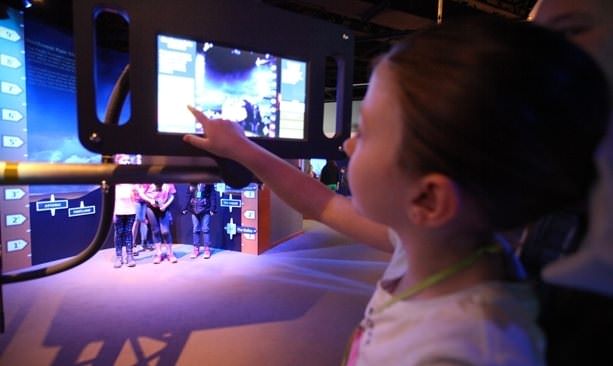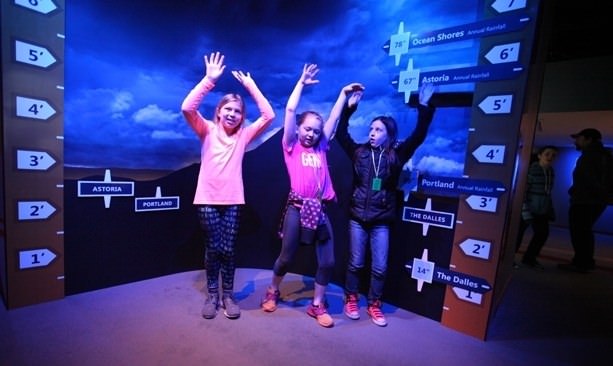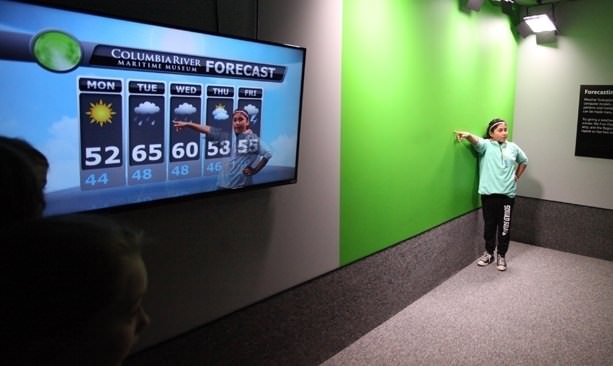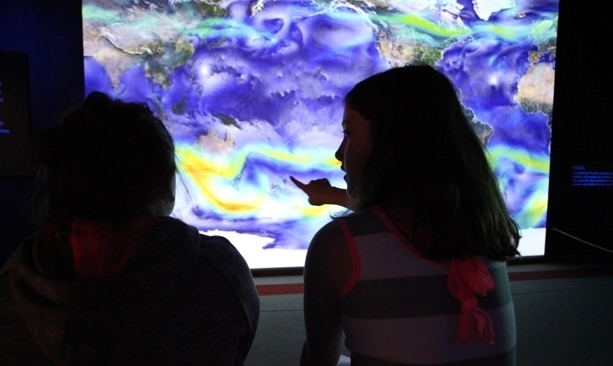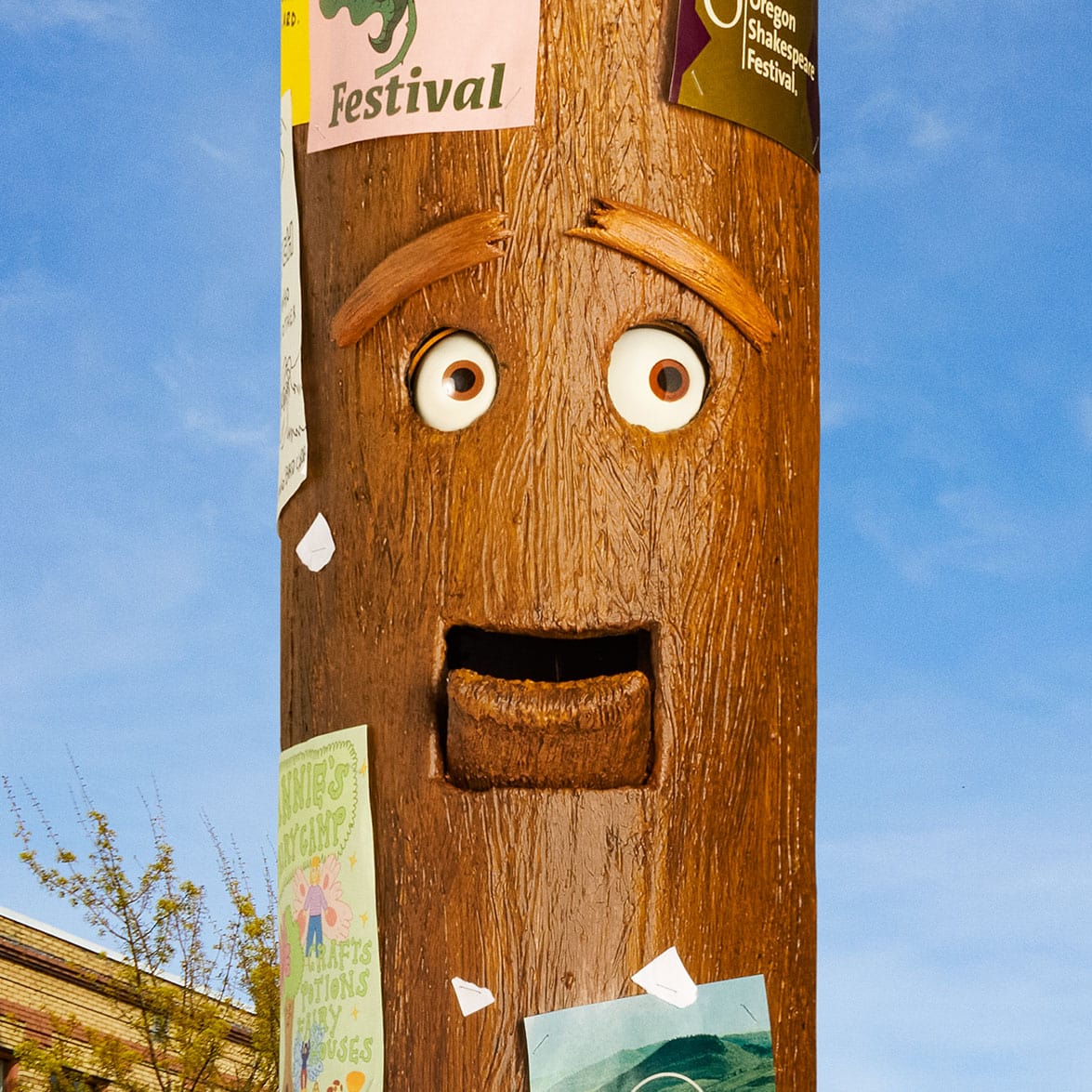Many of us have ducked into the Columbia River Maritime Museum on the downtown riverfront boardwalk in Astoria to escape the steady rainfall.
At the mouth of the Columbia River, Astoria receives 67 inches per year, compared to Portland’s 39 inches. But it could be worse. Neah Bay, at the tip of Washington’s Olympic Peninsula, sees a daunting 119 inches per year. There’s a reason the Pacific Northwest is so fantastically green.
My family learned all this at the museum at a new permanent exhibit called “Science of Storms: Northwest Weather,” which opened earlier this spring.
I took my two kids and their friends (that makes two girls, age 14, and two boys, 10 and 11) for a quick weekend excursion from Portland, and they were immediately drawn to the augmented reality station which showed the Northwest’s rain shadow effect.
Play with maps and screens
In one space, two iPads (positioned low enough for little ones) are situated across from from a walled space showing the profile of a mountain. We learned that Coast gets the soggiest weather, the west slope of the Cascade Range the rest of the rain, and then everything east of the mountains is dry.
One kid can stand in front of the wall while the other pulls up rainfall data on the tablet. The screen fills with water, inundating the kid until they look like they’re at the bottom of a swimming pool.
Tablets might be catnip to children, but even more attractive was the giant screen showing the entire globe with colorful animations of weather.
For example, the maps of ocean temperature had some surprising hot spots between Chile and Australia, and gave a sense of the fluid world of heat that gives us our weather — a foundation for the understanding of climate change.
Other maps of seawater salinity and human travel (air traffic data) proved mesmerizing, engaging the girls for 10 straight minutes. In a mock mini TV studio, they took turns delivering the weather forecast, learning to gesture in front of a green screen. Another screen is dedicated to the Beaufort Scale, which categorizes wind on water action — from a lazy day by the millpond up to a hurricane.
See yourself in infrared
I like to get my kids always wondering, “What’s digital and what’s purely analog?” This exhibit has a solid mix of both. One history-focused display shows how storms were logged in a ledger with pen and ink for much of the 20th century, and shows the simple code of flags and pennants which were flown to alert passing ships.
This code was replaced by radio and phone in the 1950s, but then brought back for small vessels. The kids looked doubtfully at a glass case containing early foghorns, which were operated by a hand crank or bellows.
A FLIR (Forward Looking Infra Red) video showed how infrared cameras are used in search and rescue. There was a live FLIR video camera to stand in front of. We enjoyed being infrared videoed and seeing on a screen who had a cold nose, and who could make handprints of heat on their own skin. The teens enjoyed the Snapchattable moment.
Watch hurricanes in 3D
For $5 extra you can see the museum’s other new addition, a 20-minute film called Hurricane 3D. This marvelous movie uses footage taken in 12 countries over the course of five years to illustrate the life cycle of a hurricane.
The storm starts as a dust storm over Senegal and gathers power over the Atlantic to become a category 4 hurricane. In Cuba, we see people storing their furniture in the rafters preparing for floods, and hunkering down with their hurricane lamps. Terrifying footage of 200-mile-an-hour winds shows a tin horse stable being dismantled, and in a deserted cityscape, palm trees bend and streetlights topple.
The camera goes up in a National Oceanic and Atmospheric Administration airplane to show pilots dropping a large tube — some form of measuring instrument, presumably — down a chute into the whirling storm, before they break the storm wall into the calm eye of the hurricane.
As the storm devastates parts of rural Cuba, we see trees falling in a wildly gyrating forest. The narrative explains how, like fire in the west, the storm revitalizes the forest by allowing new growth to appear.
Tension builds about where it will hit the United States and emergency responders try to evacuate Americans. The aftermath is depicted by a wedding dress caught on a wire fence, a lizard crawling over moldy photo albums and a tied-up puppy floating along on a broken off piece of porch. And yes, the kids were glad to see as the film wrapped that the storm-ravaged puppy found a new home.
For more things to see and do at the Columbia River Maritime Museum, read about another writer’s family visit.

